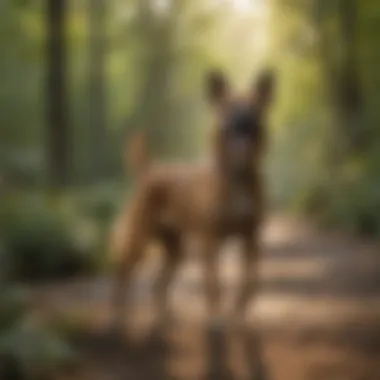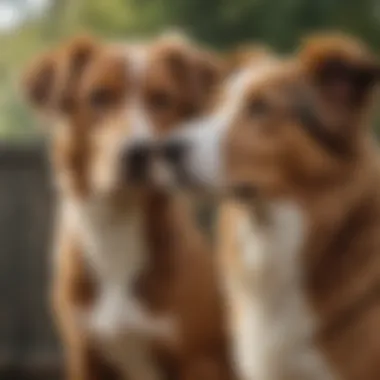Discovering Unique Dog Breeds of North Carolina


Intro
North Carolina is home to a variety of unique dog breeds, each with a distinctive history and cultural relevance. Understanding these breeds not only sheds light on the region's heritage but also enhances the appreciation for the bond shared between humans and dogs. Throughout this exploration, we will dive into the unique characteristics, historical backgrounds, and social roles of these remarkable canines.
In this article, we will discuss several key aspects of North Carolina's dog breeds, including their physical traits, temperaments, and the roles they play in local culture. We will also touch upon responsible breeding practices, care considerations, and how these breeds are integrated into the community. This discussion aims to provide comprehensive knowledge that can enrich the understanding of both current dog owners and future enthusiasts of these special breeds.
Fascinating Facts About the Animal
Unique Characteristics
North Carolina's unique dog breeds boast distinctive physical traits. For instance, the Plott Hound, known for its exceptional tracking ability, has a muscular build and a short, sleek coat that is often brindle in color. This breed is not only valued for its hunting prowess but also appreciated for its loyalty and protective nature.
In contrast, the American Bully made a name for itself with its stocky frame and broad head. Originally bred for companionship, this breed has a gentle temperament, making it suitable for families. Its short coat requires minimal grooming, which is a significant factor for busy households.
Extraordinary Abilities
These breeds are not just pets; they often possess abilities that cater to specific roles in society. For example, the Cur breed, known for its agility and intelligence, has historically been used in herding livestock. Their keen sense of smell and awareness make them excellent companions for farmers and ranchers alike.
Moreover, breeds like the Treeing Walker Coonhound demonstrate remarkable endurance. They are capable of running for miles while tracking game, displaying a level of stamina that is impressive. Each breed has carved out its niche in the local environment and has adapted to the demands placed upon them.
Behavior and Habitat
Natural Habitats
Many of North Carolina's dog breeds have adapted to diverse habitats, from coastal regions to mountainous areas. The diverse environments contribute to their behavior and temperament. The geographic nuances influence how these breeds respond to various stimuli, including wildlife and human interaction.
For example, the Plott Hound thrives in wooded regions where it can utilize its tracking skills effectively. In contrast, the American Foxhound, with a strong background in hunting, flourishes in open areas where its speed can be an asset.
Social Structures
Social structures among these dog breeds can reflect their former roles in hunting or herding. Dogs like the Plott Hound typically bond closely with their human counterparts and exhibit a natural pack mentality, creating strong familial connections with both dogs and humans. Whether in a hunting setting or as a family companion, understanding a dog's inherent social needs is crucial for successful integration into a household.
Recent Scientific Discoveries
Latest Research Findings
Recent studies have revealed significant insights into the behavior and genetics of North Carolina's dog breeds. Researchers have begun to explore the impact of breeding practices on health and temperament, emphasizing the need for responsible breeding methods. By analyzing genetic markers, it is possible to predict potential health issues and behavioral traits.
Breakthroughs in Animal Biology
Advancements in animal biology have also contributed towards better understanding of these breeds. There are ongoing studies in genetics focusing on traits such as adaptability and disease resistance. Through selective breeding practices shaped by clear findings, breeders are encouraged to maintain or enhance attributes beneficial for both performance and companionship.
Cultural Significance
Animals in Folklore
The historical significance of dog breeds in North Carolina extends into folklore. Stories featuring these animals often highlight their bravery and loyalty, serving as a testament to their relationship with humans. Local tales sometimes humanize these breeds, making them central figures in narratives that reflect regional values and traits.
Influence on Art and Literature
The cultural representation of dog breeds in art and literature is notable. Various authors and artists have drawn inspiration from these unique dogs, portraying them in ways that echo their characteristics and roles in society. The bond between humans and these breeds has become a source of insight into community values, emphasizing loyalty, resilience, and companionship.
Introducting these elements into our understanding of North Carolina's dog breeds allows for a richer appreciation of their roles in our lives. As we explore their stories, we further recognize the deep connections fostered between these magnificent creatures and their human counterparts.
Preamble to North Carolina Dog Breeds


North Carolina boasts a rich tapestry of dog breeds, each reflecting a unique blend of history, culture, and purpose. Understanding these breeds is not just a matter of curiosity; it provides insight into the state's identity and the roles dogs have played in shaping it.
First, these breeds embody the region's diverse heritage. From the early settlers’ influences to the indigenous breeds already present, each dog variety has a story. This context aids veterinarians and wildlife biologists in recognizing the health concerns or behavioral traits specific to these local breeds, enhancing animal care practices.
Furthermore, knowledge of North Carolina's dog breeds benefits families looking for potential pets. Understanding the temperaments and physical characteristics can assist in making informed decisions, ensuring a good match for families and their lifestyle.
Additionally, by exploring unique breeds, we foster appreciation for their cultural significance. This appreciation strengthens community ties and highlights ongoing efforts in responsible breeding practices. Overall, delving into North Carolina's unique dog breeds serves not just to inform, but to connect us more deeply with the dogs we cherish.
"Understanding local breeds is essential for better care and a stronger bond between humans and dogs."
In summary, the introduction to North Carolina dog breeds is a significant step toward grasping the broader themes embedded in their existence and importance.
Historical Context of Dog Breeds in North Carolina
Understanding the historical context of dog breeds in North Carolina is crucial in acknowledging how these breeds evolved. The rich history of the state reflects the blending of cultures, lifestyles, and needs of the people who called this region home. North Carolina's geographic diversity, from coastal plains to mountainous regions, created environments that shaped the characteristics, talents, and purposes of its dog breeds. Moreover, the intersection of various immigrant influences has also driven the development of unique breeds adapted to local conditions and work requirements.
The prominence of certain breeds can often be traced back to historical events. For example, the establishment of agriculture and trade routes influenced which dogs were favored for protection, herding, or hunting. This historical backdrop aids in grasping the deeper significance these breeds hold today. Insight into their origins and uses will also illuminate their role in North Carolina's cultural identity.
Indigenous Breeds and Their Origins
North Carolina has a long-standing tradition of indigenous dog breeds. The origins of these breeds can be reflected by the early Native American societies that settled in the region. They utilized dogs for various purposes such as hunting, companionship, and guard duties. The American Indian Dog is one such breed that existed long before European settlers arrived. Adapted to the local ecosystems, these dogs were prized for their endurance in hunting and for helping with livestock. Their characteristics have been shaped significantly by the environment and the tasks they undertook.
Moreover, the genetic legacy of these indigenous breeds continues with some modern North Carolina breeds. Understanding their origins articulates an important connection to the state's heritage and reminds current generations of the role these animals played in the lives of people long before them.
Influence of Early Settlers on Dog Breeding
As early settlers began to arrive in North Carolina, they brought their own dogs, which influenced local breeding practices. European breeds of various working dogs were introduced, each bringing different abilities and traits to the existing indigenous breeds. The blending of these genetics helped establish new breeds that were better suited to the local landscape and tasks. Farmers needed dogs that could assist in hunting small game, as well as guard against predators.
This intermingling of breeds resulted in the emergence of a variety of specialized dogs, including the American Foxhound and the Plott Hound. Such dogs became essential in rural life, representing a marriage of necessity and adaptability. Their presence is a testament to how evolving human needs shaped canine breeds in this region. Understanding this legacy emphasizes the importance of adaptable breeding practices and the evolution of traits over generations.
"The evolution of dog breeds in North Carolina showcases a dialogue between humans and dogs, where each influence the other continuously."
Prominent Dog Breeds from North Carolina
North Carolina is home to several unique dog breeds with distinct characteristics, temperaments, and historical importance. This section highlights the prominent dog breeds from the region, emphasizing their contributions to local culture and society. Understanding these breeds gives insights into their roles in hunting, companionship, and local folklore. Such knowledge is beneficial for families seeking a suitable pet or for veterinarians and wildlife biologists in their professional assessments.
American Foxhound
Physical Characteristics
The American Foxhound is a notably athletic breed known for its lean, muscular build. Its short coat comes in various color patterns, including tri-color and two-tone combinations. These dogs typically weigh between 40-65 pounds and stand about 21-25 inches tall at the shoulder. Their long legs and strong neck facilitate agility in hunting scenarios. The breed's keen sense of smell enables it to track scents efficiently, essential for its original purpose.
Temperament
American Foxhounds are recognized for their friendly and social demeanor. They are generally good with children and other pets, making them a popular choice for families. However, they possess a strong prey drive, influenced by their hunting background. Training this breed requires consistency and patience, but their affectionate nature often makes it worthwhile.
"Foxhounds have a unique ability to bond with their human counterparts, enhancing their roles as companions."
Historical Significance
The American Foxhound's roots trace back to early settler times in North Carolina. Developed from crosses between English hounds and local breeds, it played a vital role in hunting game such as deer and foxes. This breed's historical significance lies in its contribution to the Southern hunting traditions, showcasing the connection between dogs and the culture of the region.
Plott Hound
Physical Characteristics


Plott Hounds are powerful dogs, typically weighing 40-60 pounds. Their distinctive feature is a strong, athletic build that allows them to excel in challenging terrain. They often have a short coat, which comes in various brindle shades. Their ears are medium-sized and flop down. This breed's strong sense of smell and keen eyesight make it a formidable tracking dog.
Temperament
These dogs boast a brave and determined temperament. Plott Hounds are known to be loyal and protective of their families, making them excellent companions. With a high energy level, they require regular exercise to remain healthy. Socialization and training from a young age help shape their behavior, making them responsive and manageable pets.
Role in Hunting
Originally bred for hunting large game like bears and wild boars, Plott Hounds are incredibly effective hunters. Their strong instincts and relentless nature make them reliable companions for hunters in North Carolina. The breed’s specialized capabilities contribute significantly to hunting culture, making them valued members of hunting teams.
Catahoula Leopard Dog
Physical Characteristics
Catahoula Leopard Dogs are known for their striking appearance, often featuring a unique blend of colors and patterns, including spots or patches. They usually weigh between 45-95 pounds. Their medium to large size, coupled with their muscular build, enables them to perform various tasks efficiently. Additionally, they have a distinctive coat that can be either short or long, adapting well to different climates.
Temperament
This breed exhibits an intelligent and independent nature. While they are loyal and loving towards their families, Catahoula Leopard Dogs can be wary of strangers. They thrive on mental and physical stimulation, which means they need regular exercise and engagement. Training should focus on establishing a strong leadership role to ensure their cooperation.
Working Roles
Catahoula Leopard Dogs have a rich history in herding livestock and working with hunters. Their agility and intelligence enable them to excel in distinct roles such as search-and-rescue and detection work. This versatility makes them highly regarded in certain communities, illustrating their importance beyond mere companionship.
Chihuahua
Physical Characteristics
Chihuahuas are one of the smallest dog breeds, typically weighing 2-6 pounds. Despite their little stature, they express a bold personality. Their coat can be smooth or longhaired, existing in various colors. The resemblance between Chihuahuas highlights their uniqueness, appealing to a wide range of dog lovers.
Temperament
Chihuahuas are spirited and confident, often perceiving themselves as much larger than they are. This breed enjoys bonding closely with its family, sometimes exhibiting a protective instinct. However, socialization is crucial since they may exhibit shyness around unfamiliar people. Providing a safe environment is essential for their overall well-being.
Cultural Significance
The Chihuahua has gained recognition beyond mere companionship. They feature prominently in popular culture due to their association with celebrities and media representations. This breed connects to the community through local events and gatherings emphasizing North Carolina's cultural fabric. The Chihuahua's influence epitomizes how a dog can become a symbol of broader cultural dynamics.
Breeding Practices in North Carolina
Breeding practices in North Carolina are crucial for maintaining the integrity of the unique dog breeds that thrive in the state. This section delves into the standards and challenges that face breeders, showcasing the dedication needed to uphold quality in dog breeding. Understanding these practices is vital for veterinarians and families alike, as it connects to the overall health and well-being of the breeds in North Carolina.
Ethical breeding standards are essential for ensuring the long-term health and genetic diversity of dog breeds. Breeders must prioritize the overall welfare of the animals and comply with regulations set by organizations like the American Kennel Club. The commitment to transparency in breeding practices fosters trust among potential dog owners. These ethical standards often include:
- Health screening for hereditary diseases
- Genetic testing to prevent inbreeding
- Adoption of responsible breeding practices accessible to the public
To achieve these goals, some breeders focus on specific traits or behaviors that align with the breed’s standards. This attention to detail helps to create balanced dogs that can thrive in both companionship and working roles.
"Responsible breeders contribute to the health and happiness of their dogs, which in turn leads to better relationships with their human counterparts."
However, it is not without its challenges. Breeders in North Carolina encounter various issues that can complicate the breeding process. Among these challenges are:
- Limited access to genetic testing resources
- The pressure to produce puppies quickly to meet demand
- Issues related to proper socialization of young dogs
- The impact of state regulations and zoning laws
Faced with these difficulties, many breeders strive to balance the demands of a competitive market while adhering to high standards of practice. Furthermore, the changing landscape of dog ownership dynamics means that breeders must adapt to new trends, ensuring they remain relevant and support the local community.


The discussion of breeding practices is significant because it provides insight into how these breeds are shaped for their future roles. It also encourages potential owners to consider the importance of selecting ethical breeders—those who contribute positively to the overall landscape of dog ownership in North Carolina. By understanding these practices, families and veterinarians can engage more meaningfully in discussions about dog health, care, and community involvement.
Care and Health of North Carolina Dog Breeds
The wellbeing of dog breeds from North Carolina is vital to maintaining their unique traits and characteristics. Proper care extends beyond just companionship; it encompasses physical health, nutrition, and regular veterinary visits. Understanding these aspects can greatly influence a dog's quality of life.
Nutritional Needs
Dogs from North Carolina have varying nutritional requirements depending on their breed, age, and lifestyle. For instance, the American Foxhound, being a hunting breed, might require a higher protein diet to support its active lifestyle. On the other hand, the Chihuahua has different dietary needs due to its small size and lower energy output.
- High-Quality Protein: Essential for muscle development, especially in active breeds like Plott Hounds. Chicken, fish, and beef are good sources.
- Healthy Fats: Necessary for skin health and a shiny coat, fat can come from fish oils or flaxseed.
- Carbohydrates: Provide energy, and should come from wholesome sources such as sweet potatoes and brown rice.
- Vitamins and Minerals: Important for overall health, fruits and vegetables like carrots and blueberries can be beneficial.
Maintaining a well-balanced diet is crucial. This includes measuring portions carefully to avoid obesity. Since different breeds have unique needs, consulting a veterinarian for a tailored diet plan is wise.
Common Health Issues
Breeds from North Carolina are prone to certain health issues which can affect their well-being. Awareness of these can lead to better management and care.
- Hip Dysplasia: Common in larger breeds like the Plott Hound, this condition affects the hip joint and causes pain. Regular check-ups can help in early detection.
- Skin Conditions: Breeds like the American Foxhound may suffer from allergies or skin irritations. A proper diet and regular grooming can prevent these issues.
- Heart Problems: Notably in smaller breeds, such as Chihuahuas, heart diseases are significant concerns. Regular vet visits and monitoring can help manage this risk.
- Obesity: A critical concern for all breeds, particularly if not exercised properly. Routine exercise is essential to maintain a healthy weight.
Dogs are not just pets; they are family members. Ensuring proper care and health is an investment in their happiness and longevity.
Understanding these nutritional needs and common health issues will contribute significantly to the overall health and care of North Carolina's unique dog breeds. Keeping a consistent care routine and consulting professionals when necessary promotes a healthy bond between a dog and its owner.
Cultural Importance of Dogs in North Carolina
The cultural significance of dogs in North Carolina is multifaceted, embracing historical, social, and community aspects. Dogs serve not just as pets, but as vital contributors to local culture. Understanding their role highlights the bond between these breeds and the human population.
Several specific elements illustrate this importance:
- Historical Traditions: Dogs have been a part of North Carolina’s history for generations. They are mentioned in local folklore and have been integral to the livelihoods of many families, whether as hunting companions or protectors.
- Social Connections: Dogs foster social interactions among the community. They bring people together at parks, events, and festivals. This connection enhances social bonds and builds community spirit.
- Cultural Heritage: Specific breeds, unique to North Carolina, symbolize the state's agricultural roots and hunting traditions, showcasing the state's history and identity.
In summary, dogs in North Carolina are more than mere companions. They are significant elements of culture and community life, illuminating relationships, traditions, and shared experiences. Their presence and influence are woven into the fabric of everyday life.
Dogs in Local Folklore
Local folklore plays an important part in shaping the narrative surrounding dogs in North Carolina. Tales of legendary canines often cover heroic acts or peculiar traits, linking canines to the culture at large. For instance, stories about the American Foxhound reflect its long-standing association with hunting and companionship, portraying it as a symbol of loyalty and perseverance.
These narratives encourage appreciation for local dog breeds and branch into lessons on community values, such as bravery and fidelity. Such stories are often shared during community gatherings or passed down through generations, maintaining their relevance in social contexts.
Community Events Featuring Dogs
Community events featuring dogs illustrate North Carolina's deep-seated love for these animals. Such gatherings range from breed-specific shows to more inclusive fun days like the annual North Carolina State Fair where many dog breeds have showcases. These events allow families and dog lovers to unite, share experiences, and appreciate the unique traits of local breeds.
- Dog Shows: Events like the American Kennel Club competitions highlight the physical and behavioral attributes of various North Carolina breeds.
- Fundraisers for Local Shelters: Many community events raise funds for animal shelters, emphasizing the social responsibility of pet ownership.
- Festivals: Festivals like Bark in the Park promote awareness about responsible dog ownership while featuring activities for dogs and their owners.
Such gatherings amplify community bonds, fostering a sense of togetherness. They facilitate discussions about dog welfare, responsible breeding, and the cultural significance of dogs, promoting heartfelt connections between humans and their canine companions.
End
In this exploration of North Carolina's unique dog breeds, we see a reflection of the state's rich heritage and the evolving relationship between these animals and their human companions. Understanding the cultural importance, together with the historical context established through various breeding practices, offers valuable insights into how these breeds have become integral to local communities.
The Future of North Carolina Dog Breeds
As we look toward the future, several elements are critical for the progression of North Carolina dog breeds. First, ethical breeding practices need to be maintained and strengthened. Breeders must prioritize health and temperament over popularity or aesthetic appeal. This will help ensure the viability of these breeds for generations to come.
Next, education on breed characteristics and care is essential. Increasing awareness among dog owners about the proper training and healthcare can significantly improve the quality of life for these dogs. Engaging community programs, workshops, and veterinary clinics can play a vital role.
Additionally, the preservation of native breeds faces challenges from commercial breeding and the introduction of non-local breeds. Many North Carolina dog breeds, like the American Foxhound and the Plott Hound, hold distinct roles in hunting and agriculture. Retaining these breeds ensures a continuation of traditions that celebrate North Carolina’s cultural history.
"Understanding the breed is crucial for their future, as responsible ownership ensures that their legacy endures."







